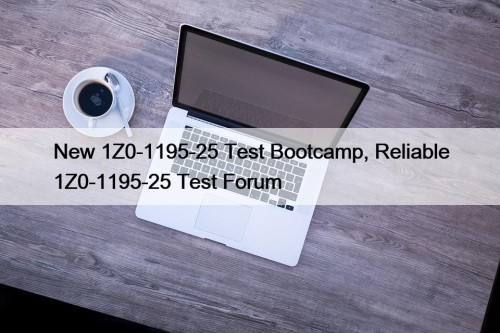Most Popular
 Quiz Fantastic AD0-E560 - Adobe Marketo Engage Architect Master Exam Details
Quiz Fantastic AD0-E560 - Adobe Marketo Engage Architect Master Exam Details
P.S. Free & New AD0-E560 dumps are available on Google ...
 Google-Ads-Video Exam Answers, Google-Ads-Video Latest Test Cram
Google-Ads-Video Exam Answers, Google-Ads-Video Latest Test Cram
Many people are afraid of walking out of their comfortable ...
 New 1Z0-1195-25 Test Bootcamp, Reliable 1Z0-1195-25 Test Forum
New 1Z0-1195-25 Test Bootcamp, Reliable 1Z0-1195-25 Test Forum
The best valid and most accurate Oracle 1Z0-1195-25 exam study ...



Excellent Exam 1Z0-1127-25 Demo & Leading Offer in Qualification Exams & Fast Download 1Z0-1127-25: Oracle Cloud Infrastructure 2025 Generative AI Professional

We have prepared our Oracle 1Z0-1127-25 Training Materials for you. They are professional practice material under warranty. Accompanied with acceptable prices for your reference, all our materials with three versions are compiled by professional experts in this area more than ten years long.
Oracle 1Z0-1127-25 Exam Syllabus Topics:
| Topic | Details |
|---|---|
| Topic 1 |
|
| Topic 2 |
|
| Topic 3 |
|
| Topic 4 |
|
Top Features of RealVCE Oracle 1Z0-1127-25 PDF Questions File and Practice Test Software
RealVCE is the best choice for those in preparation for exams. Many people have gained good grades after using our 1Z0-1127-25 exam materials, so you will also enjoy the good results. Our free demo provides you with the free renewal in one year so that you can keep track of the latest points happening in the world. As the questions of our 1Z0-1127-25 Exam Prep are more or less involved with heated issues and for customers who prepare for the 1Z0-1127-25 exam.
Oracle Cloud Infrastructure 2025 Generative AI Professional Sample Questions (Q74-Q79):
NEW QUESTION # 74
Which statement best describes the role of encoder and decoder models in natural language processing?
- A. Encoder models convert a sequence of words into a vector representation, and decoder models take this vector representation to generate a sequence of words.
- B. Encoder models take a sequence of words and predict the next word in the sequence, whereas decoder models convert a sequence of words into a numerical representation.
- C. Encoder models are used only for numerical calculations, whereas decoder models are used to interpret the calculated numerical values back into text.
- D. Encoder models and decoder models both convert sequences of words into vector representations without generating new text.
Answer: A
Explanation:
Comprehensive and Detailed In-Depth Explanation=
In NLP (e.g., transformers), encoders convert input text into a vector representation (encoding meaning), while decoders generate text from such vectors (e.g., in translation or generation). This makes Option C correct. Option A is false-decoders generate text. Option B reverses roles-encoders don't predict next words, and decoders don't encode. Option D oversimplifies-encoders handle text, not just numbers. This is the foundation of seq2seq models.
OCI 2025 Generative AI documentation likely explains encoder-decoder roles under model architecture.
NEW QUESTION # 75
Which statement is true about string prompt templates and their capability regarding variables?
- A. They can only support a single variable at a time.
- B. They are unable to use any variables.
- C. They require a minimum of two variables to function properly.
- D. They support any number of variables, including the possibility of having none.
Answer: D
Explanation:
Comprehensive and Detailed In-Depth Explanation=
String prompt templates (e.g., in LangChain) are flexible frameworks that can include zero, one, or multiple variables (placeholders) to customize prompts dynamically. They can be static (no variables) or complex (many variables), making Option C correct. Option A is too restrictive. Option B is false-variables are a core feature. Option D is incorrect, as no minimum is required. This flexibility aids prompt engineering.
OCI 2025 Generative AI documentation likely covers prompt templates under LangChain or prompt design.
NEW QUESTION # 76
How does the temperature setting in a decoding algorithm influence the probability distribution over the vocabulary?
- A. Increasing the temperature removes the impact of the most likely word.
- B. Increasing the temperature flattens the distribution, allowing for more varied word choices.
- C. Decreasing the temperature broadens the distribution, making less likely words more probable.
- D. Temperature has no effect on probability distribution; it only changes the speed of decoding.
Answer: B
Explanation:
Comprehensive and Detailed In-Depth Explanation=
Temperature adjusts the softmax distribution in decoding. Increasing it (e.g., to 2.0) flattens the curve, giving lower-probability words a better chance, thus increasing diversity-Option C is correct. Option A exaggerates-top words still have impact, just less dominance. Option B is backwards-decreasing temperature sharpens, not broadens. Option D is false-temperature directly alters distribution, not speed. This controls output creativity.
OCI 2025 Generative AI documentation likely reiterates temperature effects under decoding parameters.
NEW QUESTION # 77
In the simplified workflow for managing and querying vector data, what is the role of indexing?
- A. To convert vectors into a non-indexed format for easier retrieval
- B. To categorize vectors based on their originating data type (text, images, audio)
- C. To map vectors to a data structure for faster searching, enabling efficient retrieval
- D. To compress vector data for minimized storage usage
Answer: C
Explanation:
Comprehensive and Detailed In-Depth Explanation=
Indexing in vector databases maps high-dimensional vectors to a data structure (e.g., HNSW,Annoy) to enable fast, efficient similarity searches, critical for real-time retrieval in LLMs. This makes Option B correct. Option A is backwards-indexing organizes, not de-indexes. Option C (compression) is a side benefit, not the primary role. Option D (categorization) isn't indexing's purpose-it's about search efficiency. Indexing powers scalable vector queries.
OCI 2025 Generative AI documentation likely explains indexing under vector database operations.
NEW QUESTION # 78
What is the role of temperature in the decoding process of a Large Language Model (LLM)?
- A. To determine the number of words to generate in a single decoding step
- B. To decide to which part of speech the next word should belong
- C. To adjust the sharpness of probability distribution over vocabulary when selecting the next word
- D. To increase the accuracy of the most likely word in the vocabulary
Answer: C
Explanation:
Comprehensive and Detailed In-Depth Explanation=
Temperature is a hyperparameter in the decoding process of LLMs that controls the randomness of word selection by modifying the probability distribution over the vocabulary. A lower temperature (e.g., 0.1) sharpens the distribution, making the model more likely to select the highest-probability words, resulting in more deterministic and focused outputs. A higher temperature (e.g., 2.0) flattens the distribution, increasing the likelihood of selecting less probable words, thus introducing more randomness and creativity. Option D accurately describes this role. Option A is incorrect because temperature doesn't directly increase accuracy but influences output diversity. Option B is unrelated, as temperature doesn't dictate the number of words generated. Option C is also incorrect, as part-of-speech decisions are not directly tied to temperature but to the model's learned patterns.
General LLM decoding principles, likely covered in OCI 2025 Generative AI documentation under decoding parameters like temperature.
NEW QUESTION # 79
......
Our Oracle Cloud Infrastructure 2025 Generative AI Professional 1Z0-1127-25 questions PDF is a complete bundle of problems presenting the versatility and correlativity of questions observed in past exam papers. These questions are bundled into Oracle Cloud Infrastructure 2025 Generative AI Professional PDF questions following the official study guide. Oracle 1Z0-1127-25 PDF Questions are a portable, printable document that simultaneously plays on multiple devices. Our Oracle 1Z0-1127-25 PDF questions consists of problems in all aspects, whether theoretical, practical, or analytical.
Valid 1Z0-1127-25 Exam Question: https://www.realvce.com/1Z0-1127-25_free-dumps.html
- Related 1Z0-1127-25 Exams 🥊 1Z0-1127-25 Latest Exam Questions 📲 1Z0-1127-25 New Question 🔱 Simply search for 「 1Z0-1127-25 」 for free download on ( www.vceengine.com ) ➖1Z0-1127-25 Latest Materials
- Oracle 1Z0-1127-25 Questions To Complete Your Preparation 🤛 Search on ⏩ www.pdfvce.com ⏪ for ➽ 1Z0-1127-25 🢪 to obtain exam materials for free download 🔼1Z0-1127-25 Latest Exam Questions
- Oracle 1Z0-1127-25 Questions To Complete Your Preparation 🍾 Open “ www.pdfdumps.com ” enter ➽ 1Z0-1127-25 🢪 and obtain a free download 🔫1Z0-1127-25 New Test Bootcamp
- Professional 100% Free 1Z0-1127-25 – 100% Free Exam Demo | Valid 1Z0-1127-25 Exam Question 🐱 Easily obtain free download of ▷ 1Z0-1127-25 ◁ by searching on { www.pdfvce.com } 🥧1Z0-1127-25 Premium Exam
- 1Z0-1127-25 New Test Bootcamp 🟪 1Z0-1127-25 Hot Spot Questions 🌽 1Z0-1127-25 Exam Questions And Answers 🐌 Go to website 【 www.free4dump.com 】 open and search for ➡ 1Z0-1127-25 ️⬅️ to download for free 👞Exam 1Z0-1127-25 Dump
- Overcome Exam Challenges with 1Z0-1127-25 Oracle 1Z0-1127-25 Exam Questions 🏐 Easily obtain free download of ▛ 1Z0-1127-25 ▟ by searching on { www.pdfvce.com } 🌞1Z0-1127-25 Latest Materials
- Get Real Oracle 1Z0-1127-25 Questions From www.prep4away.com - Ace Your Exam 😁 Search for ⮆ 1Z0-1127-25 ⮄ and download it for free immediately on ( www.prep4away.com ) 🔪1Z0-1127-25 Hot Spot Questions
- Oracle 1Z0-1127-25 Questions To Complete Your Preparation 🕉 Search for “ 1Z0-1127-25 ” and easily obtain a free download on ⏩ www.pdfvce.com ⏪ 📍1Z0-1127-25 Hot Questions
- Pass Guaranteed Quiz Oracle - 1Z0-1127-25 - Exam Oracle Cloud Infrastructure 2025 Generative AI Professional Demo 🍥 The page for free download of 《 1Z0-1127-25 》 on ▶ www.testsdumps.com ◀ will open immediately 🎢1Z0-1127-25 New Test Bootcamp
- 1Z0-1127-25 Hot Spot Questions 🛃 1Z0-1127-25 Exam Questions And Answers 😥 1Z0-1127-25 Premium Exam 🛸 Search for ▷ 1Z0-1127-25 ◁ and download it for free immediately on ▶ www.pdfvce.com ◀ 📳1Z0-1127-25 Reliable Exam Question
- 1Z0-1127-25 Exam Dumps.zip ⚔ 1Z0-1127-25 Latest Exam Questions 🧐 Guaranteed 1Z0-1127-25 Questions Answers 🛂 Search for ⏩ 1Z0-1127-25 ⏪ on ⏩ www.getvalidtest.com ⏪ immediately to obtain a free download 🐜Practice 1Z0-1127-25 Test Online
- 1Z0-1127-25 Exam Questions
- peopleoffaithbiblecollege.org focusonpresent.com bicfarmscollege.com maintenance.kelastokuteiginou.com ignouclasses.in lms.rilosmals.com int.yigebbs.top rickwal840.blogsidea.com skillcraze.com lifeshine.themespirit.com
Tags: Exam 1Z0-1127-25 Demo, Valid 1Z0-1127-25 Exam Question, 1Z0-1127-25 Test Result, 1Z0-1127-25 Exam Brain Dumps, 1Z0-1127-25 Certification Book Torrent